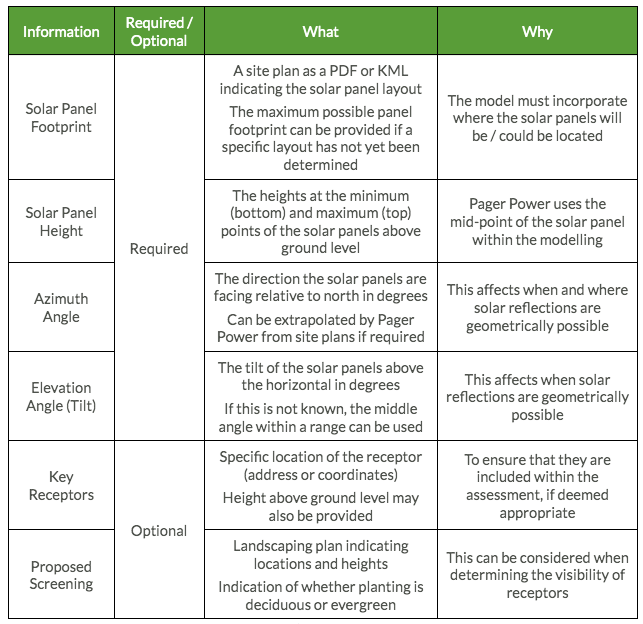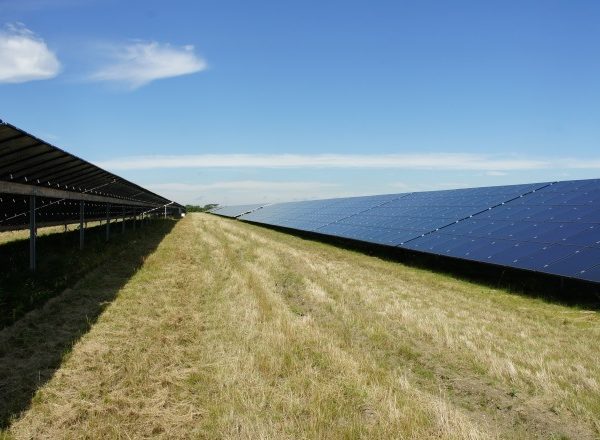Glint and glare assessments require undertaking modelling to determine the locations and times at which solar reflections are geometrically possible. In this article, we explain what the technical requirements are when undertaking a glint and glare assessment for fixed panels, which will need to be incorporated into the modelling.
For a quick overview of the technical requirements, see Table 1 below. Further explanation and context is provided in further sections.
Table 1 Technical requirements overview – fixed panels.
Required Information
The required information is the set of inputs that must be provided to undertake the glint and glare modelling.
An explanation of what is required, as well as some potential alternatives if this information isn’t yet available, are presented below.
Solar Panel Footprint
Glint and glare modelling is contingent on mapping the solar panel areas because no analysis can be undertaken if the solar panel locations have not been defined.
If a specific footprint has not yet been determined, the developer may choose to provide the maximum possible panel footprint as this will represent the worst-case scenario and would help identify any ‘problem areas’.
Pager Power must be provided with the current version of the solar panel layout or the maximum possible panel footprint. The site plan can be provided in PDF or KML format.
Solar Panel Height
The glint and glare model uses a singular solar panel height instead of using multiple points between the minimum (bottom) and maximum (top) heights of the panel.
Pager Power recommends using the mid-point of the solar panel as the singular height. The main risk of using the top of the panel is that the model may incorrectly assume an observer with an eye height lower than the entire panel and therefore unaffected. This limitation exists if the centre is used, but it is minimised because the height difference is smaller.
Pager Power must be provided the heights at the minimum (bottom) and maximum (top) points of the solar panel so that the mid-point can be determined. The maximum height or another fixed panel height may also be provided as an alternative, if preferred.
Azimuth Angle
The azimuth angle relates to the directions are facing relative to north – fixed solar panels are typically south facing (180 degrees). The azimuth angle typically has the greatest impact on when and where solar reflections are geometrically possible and therefore could be considered one of the most important technical requirements.
Pager Power must be provided the azimuth angle of the solar panels or with a plan from which the azimuth angles can be extrapolated.
Elevation Angle (Tilt)
The elevation angle is the tilt of the solar panels above the horizontal (sometimes referred to as pitch) – a typical range in the UK is between 10 and 30 degrees. The elevation angle typically dictates the times at which solar reflections occur rather than where they are geometrically possible.
If the exact elevation angle is undecided, Pager Power recommends assessment of the middle angle within the possible range as this represents the smallest variation from the minimum and maximum angles and therefore the smallest possible difference in modelling results.
Pager Power must be provided the elevation angle of the solar panels or the range of elevation angles being considered.
Optional Information
As well as the required information, additional details that can provide further context but isn’t strictly required to undertake the modelling can be provided.
The optional information must be provided at or before the time of instruction if it is to be incorporated within the assessment.
Key Receptors
As part of Pager Power’s glint and glare methodology, the relevant receptors in the surrounding area will be identified and included in the modelling. However, additional key receptors can be identified by the developer to ensure that they are included within the assessment, if deemed appropriate.
Pager Power must be provided the specific location of the receptor (address or coordinates). The height above ground level may also be provided but can also be extrapolated by Pager Power.
Proposed Screening
To determine the impact upon a surrounding observer, the visibility of the reflecting panels should be determined. Pager Power considers existing and proposed screening when determining visibility; therefore, any planting as part of the landscaping proposals can be considered.
Pager Power must be provided the landscaping plans identifying the locations and heights of the proposed planting. It should also be confirmed whether the proposed planting will be deciduous or evergreen.
Conclusions
The technical requirements are an essential part of the glint and glare assessment because they underpin the technical modelling and assessment as a whole.
It should be ensured the details are as accurate as possible so that the modelled effects accurately represent the real-life scenario once the project is built.
About Pager Power
Pager Power has undertaken more than 1000 glint and glare assessments in the UK and overseas. Pager Power has experience assessing potential glare effects in accordance with its own glare guidance, and other guidelines and regulations.
To download the latest edition of Pager Power’s Glint and Glare Guidance, click here.
Thumbnail image accreditation: Zbynek Burival (March 2018) from Unsplash.com. Last accessed 17th April 2023. Available at: https://unsplash.com/photos/V4ZYJZJ3W4M




